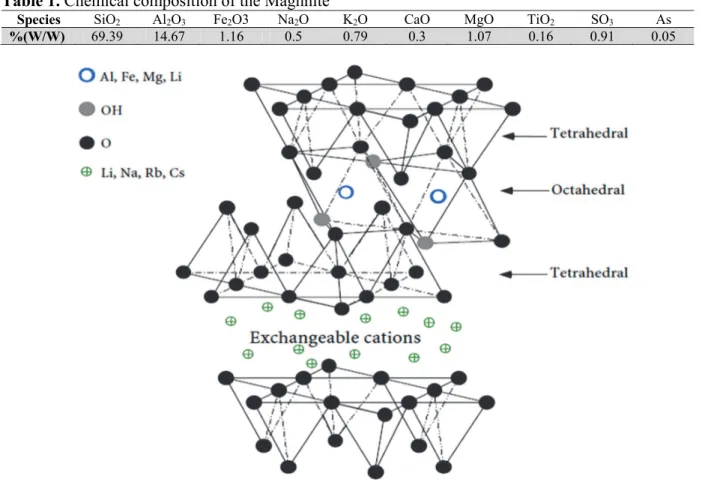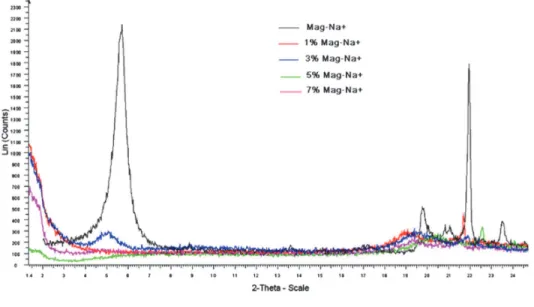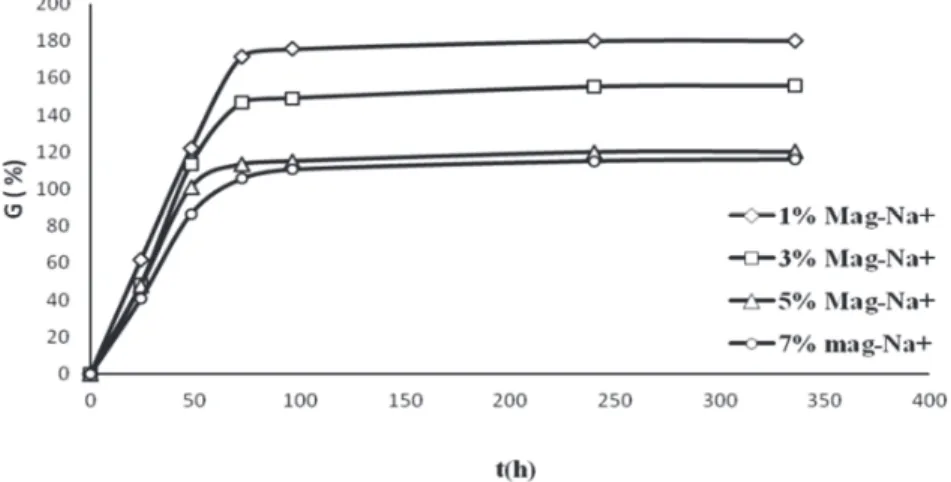* Corresponding author.
E-mail address: fatiha_reguieg@yahoo.fr (F. Reguieg) © 2017 Growing Science Ltd. All rights reserved. doi: 10.5267/j.ccl.2016.11.005
Current Chemistry Letters 6 (2017) 69–76
Contents lists available at GrowingScience
Current Chemistry Letters
homepage: www.GrowingScience.com
Hydrogel composite of poly(vinylalcool) with unmodified montmorillonite
Fatiha Reguiegab*, Nabahat Sahlia and Mohamed Belbachira
a,
Laboratory of Polymer Chemical, Department of Chemistry, Faculty of Exact and Applied Sciences, University of Oran1 Ahmed Benbella, 31100 Oran, Algeria
b
Preparatory School in Sciences and Technology. Oran, Algeria
C H R O N I C L E A B S T R A C T
Article history: Received August 21, 2016 Received in revised form October 24, 2016
Accepted 21 November 2016 Available online
21 November 2016
Crosslinked poly(vinylalcohol) (PVA) hydrogel composites based on algerian hydrophilic natural Na-montmorillonite (Na-MMT) nanoclay named Maghnite-Na (Mag-Na) were prepared in aqueous media, without utilization of chemical crosslinking agents, by repeated cycles of freezing and thawing. The morphology of hydrogel composites and their swelling in water at different amount of Mag-Na were investigated. The characterization of obtained hydrogel composites by X-ray diffraction (XRD) showed a remarkable increase of the basal distance of Mag-Na in PVA hydrogels. Therefore, Intercalated and exfoliated morphology was observed for prepared composites hydrogels of PVA. The infra-red (FTIR) characterization results showed that some interactions have been developed between the hydroxyl groups of PVA chains and Mag-Na in composite hydrogels. Introducing Mag-Na into PVA hydrogel affected their swelling. Increased amount of Mag-Na decreased the equilibrium degree of swelling and equilibrium water content.
© 2017 Growing Science Ltd. All rights reserved. Keywords: Hydrogel composite PVA Maghnite-Na Freezing-thawing Physical crosslinking 1. Introduction
Hydrogels are three-dimensional cross-linked polymer network that can respond to the fluctuations of the environmental stimuli. These materials can incorporate large quantum of biological fluids and swell. When swelled, they are soft and rubbery and resemble the living tissue, exhibiting excellent
biocompatibility.1
Poly(vinyl alcohol) (PVA) is a water soluble polymer of great importance because of its many appealing characteristics specifically for various pharmaceutical and biomedical applications. PVA hydrogels possess an elastic or rubbery nature structure and high degree of swelling in water or
biological fluids.2
PVA hydrogels have been applied in different biomedical application sites such as contact lenses,
70
Hydrogel nanocomposites on the basis of nanometer-thin layered materials, like sodium montmorillonite (Na-MMT), have attracted strong interest in today’s materials research, as it is possible to achieve impressive enhancements of material properties compared to the pure hydrogels. Mixed with
clay, PVA hydrogel have excellent mechanical properties and thermal stability.4 Because of their
biocompatibility, PVA composites hydrogels have been used extensively in the medical field: joint replacement, cartilage replacement, controlled drug delivery, wound dressing as it can prevent loss of
body fluid, permeable to oxygen and be a barrier against bacteria.5
Sodium montmorillonite (Na-MMT) is natural clay occurring 2:1 phyllosilicate, capable of forming stable suspensions in water. This hydrophilic character of MMT, due to the presence of sodium cation in the clay galleries, also promotes high dispersion of these inorganic crystalline layers in water-soluble
polymers such as poly(vinyl alcohol),6 poly(ethylene oxide). 7, 8 and poly(1,3-dioxolane)9
Maghnite is Algerian montmorillonite sheet silicate clay with very high cation exchange property.10
Its structure is octahedral layers comprise between two tetrahedral layers. Between two successive
sheets, there is an interlayer space which contains exchangeable cations (Fig. 1).
Maghnite, which has a high ratio of silicium and aluminium10 (Table1), is used in several scientific
field, as non-toxic catalyst for the polymerization of different monomers,11, 12 and as nanofiller for the
synthesis of polymer/clay and hydrogels/clay nanocomposites.13, 14 nanocomposite based on Maghnite
clay exhibit improved mechanical, thermal, barrier and flame retardant properties in comparison with
unfilled polymer or hydrogel.15
Table 1. Chemical composition of the Maghnite10
Species SiO2 Al2O3 Fe2O3 Na2O K2O CaO MgO TiO2 SO3 As
%(W/W) 69.39 14.67 1.16 0.5 0.79 0.3 1.07 0.16 0.91 0.05
Crosslinking in hydrogels occurs by chemical or physical means depending on the polymer properties and experimental conditions. A chemical process is utilized to prepare a chemical hydrogel using chemical crosslinking agents.
In physical hydrogels, the crosslinking is achieved via utilizing physical processes such as association, aggregation, crystallization, complexation, and hydrogen bonding.
Crystallization by Freezing-thawing is one of the effective physical methods to produce the PVA hydrogel composites. By repeated freezing-thawing process, the PVA hydrogels formed are non-toxic and strong. This preparation method of nanocomposite hydrogels is safer in the absence of co-solvent
and chemical crosslinking agents.16, 17
In the most research work, PVA is mixed with an organically modified montmorillonite which has
hydrophobic environment.17, 18 However PVA is an hydrophilic polymer and it can be blended with
unmodified montmorillonite which has an hydrophilic environment for the synthesis of hydrogels nanocomposites hydrogels, and this is our objective in this present work. Consequently, series of freeze-thawed Poly(vinylalcohol) (PVA) composite hydrogels were prepared using the Algerian hydrophilic
montmorillonite-Na nanoclay called Maghnite-Na (Mag-Na).10 The effect of Mag-Na quantity on the
morphology and swelling behavior of nanocomposite hydrogels were investigated.
2. Results and discussion
2.1. Structure of PVA/Mag-Na hydrogel composites
2.1.1. X-ray Diffraction (XRD)
The DRX profiles of Mag-Na and PVA hydrogel composites are shown in Fig. 2. For the Mag-Na,
typical peak of Na-MMT is shown at around 2θ=5,5°, which represents the (d001) spacing at 15A°. In
the XRD profile of PVA hydrogel composite with 1, 5 and 7% of Mag-Na, the typical Mag-Na peak
initially at 2θ=5,5° was disappeared which indicate that were strong increase in the interlayer spacing
of Mag-Na. It could be concluded that the chains of PVA has intercalated between silicate layers during the freezing-thawing process.
72
2.1.2 Fourier Transform Infrared Spectroscopy (FTIR)
FTIR spectra shown in Fig. 3 were obtained for pure Maghnite-Na, pure PVA hydrogel and hydrogel
composites of PVA/Mag-Na. For the final product of hydrogel composite of PVA/Mag-Na, the bands
at around 500 and 1000 cm-1 corresponding to the SiO stretching vibration of clay are due to the
presence of the Na in the PVA/Na hydrogel composite. The OH stretching bands of the
Mag-Na initially at around 3650 cm-1 was shifted to lower wave number and combined with the OH streching
bands of the PVA (3500-3000 cm-1). This combination led to a broader hydroxyl stretching band. This
broader band notes that incorporation of Mag-Na into PVA developed some interactions between the OH groups of PVA and Mag-Na.
Fig. 3.FTIR spectrum of Mag-Na, PVA and hydrogel composite PVA/Mag-Na
2.2 Swelling and water content measurement
The swelling behavior of PVA hydrogels prepared by freezing-thawing technique was examined in
distilled water. Fig. 4 shows the equilibrium swelling rate measured at different times, for different
amounts of Mag-Na. Significant absorption of water at the beginning is observed in gels and maximum swelling equilibrium is reached after 72 hours of contact with distilled water.
Fig. 4. Swelling kinetic curve of hydrogel composite PVA (10%)/Mag-Na
The effect of the amount of Mag-Na on the equilibrium swelling and the amount of water in the gel
is also shown in Fig. 5 and Fig. 6. For the pure hydrogels (0% Mag-Na), the physical network of
Mag-Na
PVA
PVA/Mag-Na is able to retain between its macromolecular chains up to 200% water of its weight in the dry state for the hydrogel containing 5% PVA, up to 180% water of its weight in the dry state for the hydrogel to 10% PVA and up to 160% water by weight in the dry state for the hydrogel to 15% PVA. Increasing the amount of PVA increases the cristallinity and rigidity of the network then the swelling decreases.
In the presence of the Mag-Na within the network, whatever the content of the PVA hydrogel, we observe a decrease in degree of swelling at equilibrium and the amount of water retained with increasing the amount of Mag-Na. This is often noted in the case of chemical crosslinking where the
swelling ratio decreases with increase in the amount of crosslinking agent.19 It can be deduced that the
Mag-Na acts as a crosslinking agent by hydrogen bond with the PVA linear chains during the freezing-thawing process. The amount of water absorbed by the gel is related to the physical crosslinking degree, the hydrophilic character of the Mag-Na and the PVA content as well as the barrier effect of Mag-Na sheets that keep down water molecules from penetrating within the network of PVA/Mag-Na hydrogel composite.
Fig. 5. The swelling of hydrogel composite PVA/Mag-Na
Fig. 6. The water content in hydrogel composite PVA/Mag-Na 10
20 30 40 50 60 70 80
0% 2% 4% 6% 8%
wate
r
co
n
te
n
t
(%)
amount of Mag‐Na+(% weight)
74
3. Conclusion
Composite hydrogels of poly (vinyl alcohol) (PVA) with an unmodified maghnite (Mag-Na) were prepared at different morphologies: exfoliated, intercalated and intercalated-flocculated by freezing-thawing method. The swelling ratio at equilibrium of PVA composite hydrogels decreases with increasing the amount of the maghnite-Na in the hydrogel and increases with increasing PVA content. Increasing the amount of the maghnite in the hydrogel leads to an increase of the network rigidity and a decrease in its swelling. Increasing the PVA content in the hydrogel leads to increased hydrophilicity of the network and its swelling.
Acknowledgements
The author would like to thank the engineer, ADDOU Amine, of the polymer chemical laboratory of Oran for these efforts in the analyzes of all samples.
4. Experimental
4.1Materials
PVA (CAS N° 9902-89-5), having an average molecular weight of 86000 g.mol-1 and degree of
hydrolysis of 98%, was purchased from aldrich. Algerian montmorillonite clay (Maghnite) used was supplied by a local company (ENOF Maghnia).
4.2Preparation of Maghnite-Na (Mag-Na)
Maghnite-Na was prepared as follows: crushed raw maghnite (10 g) was dispersed in (250 ml) of NaCl aqueous solution (1M). The mixture was stirred vigorously for 48 hours at room temperature, and then Mag-Na was formed. The separated Mag-Na was washed with large volume of distilled water and filtered several times until the excessive anionic entity (Cl¯) was completed removed. Removing Cl¯
ions is tested by introduction of AgNO3 salt, if Cl¯ ions are present, AgCl salt precipitates as a white
powder. Then, Mag-Na was dried in vacuum oven 100°C. Mag-Na was characterized by XRD and FTIR (see Fig. 2 and Fig. 3).
4.3 Preparation of PVA-Mag-Na composites hydrogels
A series of PVA/Mag-Na hydrogels comoposites were prepared by repeated cycles of freezing and thawing method by using various amount of PVA and Mag-Na following this table:
PVA (% by weight) 5 10 15
Mag-Na (% by weight) 0 1 3 5 7 0 1 3 5 7 0 1 3 5 7
To prepare each hydrogel, the necessary amount of Mag-Na was stirred with 10 mL of deionized water for 2 hours to gain a desirable Mag-Na suspension. Then, the necessary weight of PVA powder was added gradually to the Mag-Na suspension and the solution was heated at 80°C for 2 hours with stirring to achieve complete dissolution. The obtained aqueous solutions were then poured into moulds and placed at -20°C for 24 hours to produce gel formation. A gel is formed as a consequence of cristallization of PVA molecules. After freezing process, the obtained gels were thawed for 24 hours at room temperature. The freezing-thawing cycles were repeated four times for each solution.
Mag-Na, pure PVA hydrogel and all obtained PVA/Mag-Na hydrogel composites were examined using X-ray diffractometry (XRD) and Fourier Transform Infrared spectroscopy (FTIR). X-ray diffraction analysis (XRD) was carried out at room temperature on a Bruker D8 Advance X-Ray
diffractometer (40 kV, 30 mA) using CuKα radiation (λ = 0.154 nm) at the rate of 2° min in the 2θ
range of 2.0-80°. FTIR analyses were carried out using the PerkinElmer Spectrum Two FT-IR with UATR sampling accessory.
4.5Swelling and water content measurement
The pre-weighed sample of each hydrogel was immersed into excess of deionized water for five days to extract uncrosslinked species. After this, the samples were dried at room temperature. To swell, the rinsed and dried samples were immersed into excess of deionised water at room temperature until swollen mass showed constant weight. The equilibrium degree of swelling (S%) and equilbrium water content (W%) were calculated respectively as follows :
% (1)
W % (2)
where Ws is the swollen weight of the sample at equilibrium state and Wd is the final dry of the rinsed sample.
References
1 Prashant PK., Vivek BR., Deepashree ND., and Pranav PP. (2012) Hydrogels as a drug delivery
system and applications. Int J Pharm Sci., 4 (1) 1-7.
2 Chan L.W., Hao, J.S. and Heng, P.W.S., (1999) Evaluation of permeability and mechanical
properties of composite polyvinyl alcohol films. Chem. Pharm. Bull., 47 (10) 1412–1416.
3 Gonzalez J.S., Maiolo A.S., Hoppe C.E. and Alvarez V.A., (2012) Composite gels based on
Poly(vinyl alcohol) for biomedical Uses, Proc Mat Sci., (1) 483 – 490.
4 Sinha Ray, S., Okamoto, M., (2003) Polymer/layered silicate nanocomposites: a review from
preparation to processing. Prog in Polym Sci., 28 (11) 1539-1641.
5 Muppalaneni S, Omidian H (2013) Polyvinyl Alcohol in Medicine and Pharmacy: A Perspective. J
Develop Drugs, 2 (3) 1-5.
6 Andreas A., Sapalidis, Fotios K. Katsaros and Nick K. Kanellopoulos (2011) PVA/ Montmorillonite
Nanocomposites: Development and Properties, in: Dr. John Cuppoletti (Ed.), Nanocomposites and
Polymers with Analytical Methods, ISBN: 978-953-307-352-1, InTech., 29-50.
7 Vaia, R.A., Vasudevan S., Krawiec W., Scanlon J.C, and Giannelis E.P., (1995) New Polymer
Electrolyte Nanocomposites: Melt Intercalation of Poly(ethylene oxide) in Mica-Type Silicates. Adv
mater., 7 (2) 154-156.
8 Aranda, P., and Ruiz-Hitzky E., (1992) Poly (ethylene oxide)-Silicate Intercalation Materials. Chem
of Mater, 4 (6) 1395-1403.
9 Fatiha Reguieg, Nabahat Sahli and Mohammed Belbachir, (2015), Nanocomposite Hydrogels Based
on Water Soluble Polymer and Montmorillonite-Na+, Orient. J. Chem., 31 (3) 1645-1657
10 Belbachir M., Bensaoula A. (2006) Composition and method for catalysis using bentonites. US
7094823 B2.
11 Fatiha Reguieg, Nabahat Sahli, Mohamed Belbachir, Pierre J. Lutz, (2006), One-Step Synthesis of
Bis-Macromonomers of Poly(1,3-dioxolane) Catalyzed by Maghnite-H, J. App.l Polym. Sci., 99 (6)
76
12 Bensaada N., Ayat M., Meghabar R., Belbachir M., (2015) The synthesis of polystyrene with a
new chemical approach. Curr. Chem. Lett., 4 (2) 55–60.
13 Harrane, A., Belbachir M., (2007) Synthesis of biodegradable polycaprolactone/montmorillonite
nanocomposites by direct in-situ polymerization catalysed by exchanged clay. Macromol. Symp.,
247 (1) 379–384.
14 Kherroub D.E., Belbachir M.; Lamouri S., Bouhadjar L., Chikh K, (2013) Synthesis of
polyamide-6/montmorillonite nanocomposites by direct in-situ polymerization catalysed by exchanged clay.
Orient J. Chem., 29 (4) 1429–1436.
15 Ray SS, Okamoto M. (2003) Polymer-layered silicate nanocomposite: a review from preparation to
processing. Prog Polym Sci., 28 (11) 1539–1641.
16 Paranhos M., Bluma Soares G., Renata Oliveira N., Luiz Pessan A., (2007) Poly(vinyl
alcohol)/Clay-Based Nanocomposite Hydrogels: Swelling Behavior and Characterization.
Macromol. Mater. Eng., 292 (5) 620–626.
17 Kokabi M., Hassan Z.M., (2012) Swelling Behavior and Structural Characteristics of Polyvinyl
Alcohol/Montmorillonite Nanocomposite Hydrogels, J. Appl. Polym Sci.,123 (1) 50–58
18 Kokabi M., Sirousazar M., Hassan Z.M., (2007) PVA-clay nanocomposite hydrogels for wound
dressing, Europ. Polym. J., 43 (3) 773-781.
19 Hosseinzadeh H., (2013) Synthesis and swelling properities of a poly(vinyl alcohol)-based
superabsorbing hydrogel. Curr. Chem. lett., 2 (3) 153-158.


